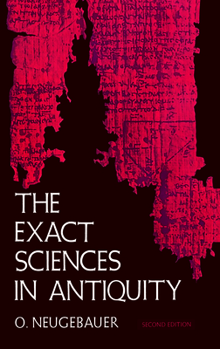The Exact Sciences in Antiquity
Select Format
Select Condition 
Book Overview
Based on a series of lectures delivered at Cornell University in the fall of 1949, and since revised, this is the standard non-technical coverage of Egyptian and Babylonian mathematics and astronomy, and their transmission to the Hellenistic world. Entirely modern in its data and conclusions, it reveals the surprising sophistication of certain areas of early science, particularly Babylonian mathematics. After a discussion of the number systems used...
Format:Paperback
Language:English
ISBN:0486223329
ISBN13:9780486223322
Release Date:June 1969
Publisher:Dover Publications
Length:288 Pages
Weight:0.71 lbs.
Dimensions:0.6" x 5.4" x 8.5"
Related Subjects
History Math Mathematics Science Science & Math Science & Scientists Science & TechnologyCustomer Reviews
4 ratings
Quick guide to pre-Greek mathematics and astronomy
Published by Thriftbooks.com User , 18 years ago
The Babylonians were good guys. They had a sophisticated, table-based system of arithmetic, they could solve quadratic equations, etc. For all this we respect them, but for Plimpton 322 we love them--surely only true connoisseurs of numbers would produce a table of Pythagorean triples. The Egyptians on the other hand disappoint us. Their arithmetic "is probably best described as a retarding force" and their astronomy "remained through all its history on an exceedingly crude level" (p. 80). To be fair, their simple-mindedness did lead them to one great creation, namely "the only intelligent calendar which ever existed in human history", to be contrasted with e.g. "the chaotic Greek calendars, depending not only on the moon but also on local politics for its intercalations" (p. 81). Neugebauer's favourite topic is Babylonian astronomy. "The very backbone of Babylonian mathematical astronomy" (p. 102) is period relations, like 235 lunar months = 19 solar years. From here they build up a quite sophisticated, purely arithmetical system "excellently adapted to practical computation and to predicting new moons, eclipses, etc." (p. 114). "At no point of this theory are the traces of a specific geometrical model visible" (p. 110), so the Babylonian theory is completely different from the Ptolemaic theory. "Nevertheless, Babylonian influence is visible in two different ways in Greek astronomy: first, in contributing the basic empirical material ... second, in a direct continuation of arithmetical methods which were used simultaneously with and independently of the geometrical methods" (p. 156); apparently even the Greeks didn't want to pull out their trig tables for every little thing. Throughout the book there are also notes on various aspects of historical scholarship, including delightfully subjective remarks like "The much publicized 'progress' in the study of the history of science is difficult to reconcile with the shocking neglect of a great wealth of source material ... What we really need is not bibliographies and summaries, but competent publications of Islamic, Greek, and Latin treatises" (p. 55).
exact
Published by Thriftbooks.com User , 21 years ago
An `old fashioned' text where the notes are as important as the body. The `Method' is the `As it really was' school. The author was a German mathematician who was drawn to Mesopotamian mathematics and astronomy early in the 20th century. Where used Greek or Latin is translated. The more modern European languages of French and especially German are extensively referred to in the notes but NOT in the body.The book is much more `Eurocentric' than is `politically correct' these days. By example the `zero symbol' is attributed to Greece, thence to Egypt then to the Orient. Others disagree. This author presents data, lists and writings from the original sources ... he has received `lifetime awards' form mathematical societies but the popular press has called other authors on zero, "ball buster's" This book is a very deep investigation of the topic of the title. While not a `page turner' for most if one relishes tidbits of fascinating information on numbers, antique maths, astronomical methods and spends the time to read the notes as well as the text when they finish this book they will have a good grip of the breadth of Mesopotamian knowledge of these subjects.
examines specific points rather than myths or stories
Published by Thriftbooks.com User , 25 years ago
Readers purpose for examining the material was a search for more information into Egyptian use of Fibonacci sequences, specifically whether they used 1st. or 2nd. order, since it is known that the Italian was not the first. Readers questions in this regard were answered although not directly.Author of book makes case why astronomy did not evolve from astrology. Although author is not math intensive, author has incredible insight into the human subconsciousness role and direction into math as used by these early peoples. Reader was able to re-work, from the Astronomy section of MathCad, the base 60 calculator used by the Babylonians, (one was also constructed for the Eygptians in their base but is not nearly as interesting) and reflects how clearly the author had submitted the interpretations for the reader to follow. This book is gem.
An excellent overview of learning in Babylon and Egypt.
Published by Thriftbooks.com User , 26 years ago
This book explains the level of learning and advance of knowledge that was aquired by the ancient cultures in Bablyon, Sumer, and Egypt. It gives a good overview of the mathematics, and astronomy that was aquired in these cultures, and the progression of this to the more modern Greek and Roman cultures.





